Arabica and Robusta coffee beans are the two most popular coffee varieties in the world, yet they possess very different characteristics. Understanding the advantages and disadvantages of each type helps you choose the coffee that suits your taste preferences and daily energy needs. Let’s explore the differences between these two coffee varieties with Hello5coffee in the article below!
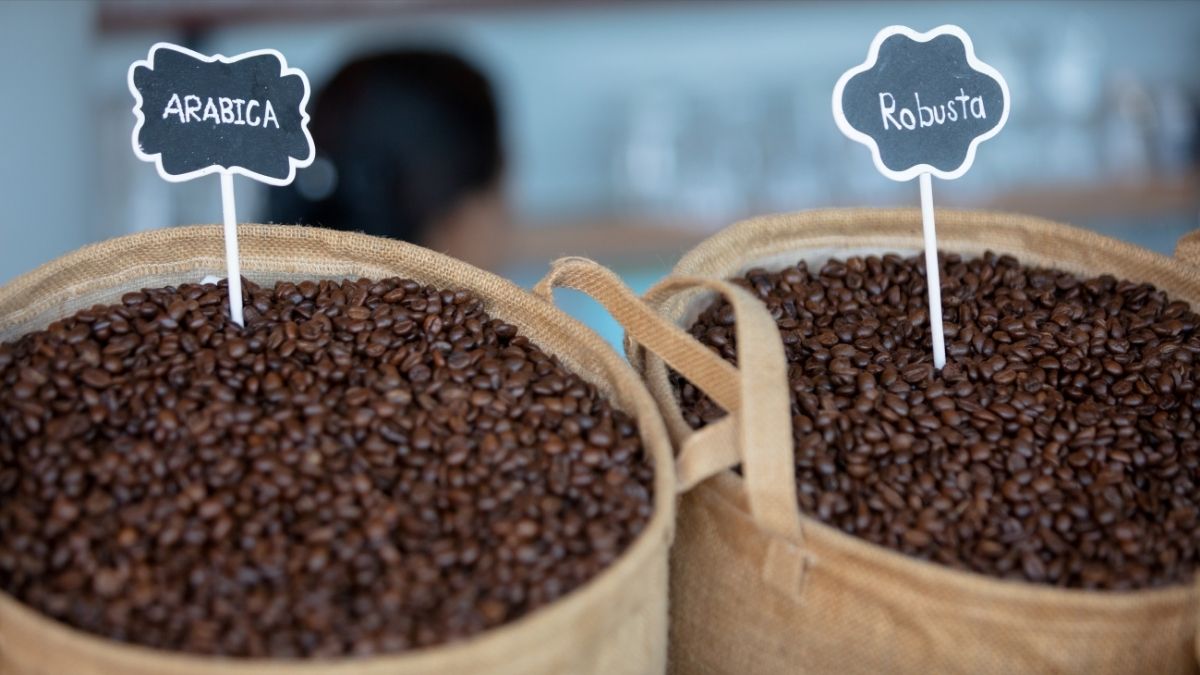
What are Arabica vs Robusta Coffee Beans?
Arabica and Robusta coffee beans are two varieties that account for the majority of global coffee production (approximately 95%). Each type has distinct growing characteristics and unique flavors.
Arabica beans originate from the Ethiopian highlands, preferring temperate climates at elevations of 600–2,000 meters. They produce oval-shaped, thin beans with curved grooves, offering complex aromas with notes of fruit, chocolate, and caramel, along with a light, pleasant acidity and minimal bitterness.
Meanwhile, Robusta beans originate from sub-Saharan regions, tolerating high temperatures well. They produce thick, round beans with straight grooves, delivering strong bitter flavors with woody and peppery notes, plus significantly higher caffeine content compared to Arabica. Understanding the differences in origin, bean structure, and flavor profiles between Arabica vs Robusta will help coffee enthusiasts choose the type that matches their preferences and energy requirements.
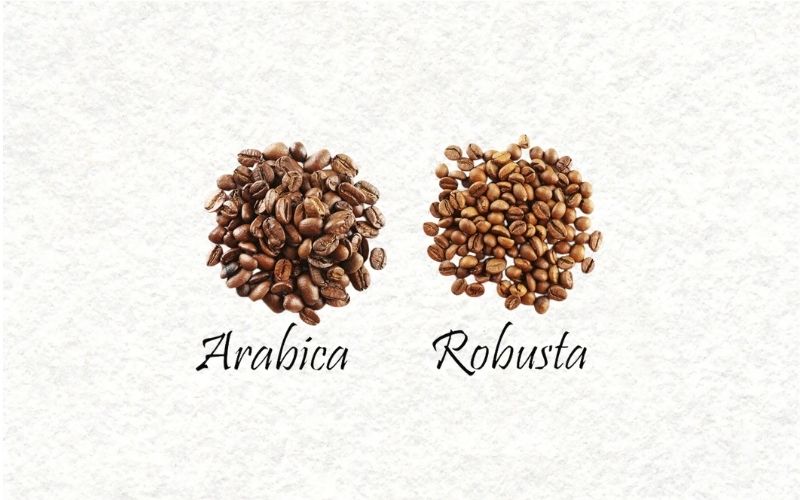
Origin and Distribution of Arabica vs Robusta
Arabica has a longer history, growing in cool highland regions, while Robusta is more resilient, tolerating heat and humidity better, making it suitable for both highland and lowland cultivation.
Historical Origins of Arabica vs Robusta Coffee Beans
Arabica coffee originates from the highlands of southwestern Ethiopia, near the Great Rift Valley. It was first discovered by humans over 1,000 years ago, linked to the legend of the goat herder Kaldi. From Ethiopia, Arabica beans spread to Yemen (15th century) and quickly became a traditional beverage in the Middle East. By the 17th-18th centuries, Arabica appeared throughout Europe, Asia, and Latin America, forming numerous local varieties like Typica, Bourbon, and Mocha.
In contrast, Robusta coffee appeared later, around the early 19th century in the Congo region – present-day Democratic Republic of Congo. At that time, Robusta beans were still wild around Lake Victoria (Uganda). The advantage of this variety was its resistance to leaf rust disease and heat tolerance. They developed rapidly, becoming a strong supplement to Arabica after disease outbreaks in the late 19th century. From Africa, Robusta was gradually introduced to Java – Indonesia, then spread widely throughout Southeast Asia, South Asia, and Latin America.
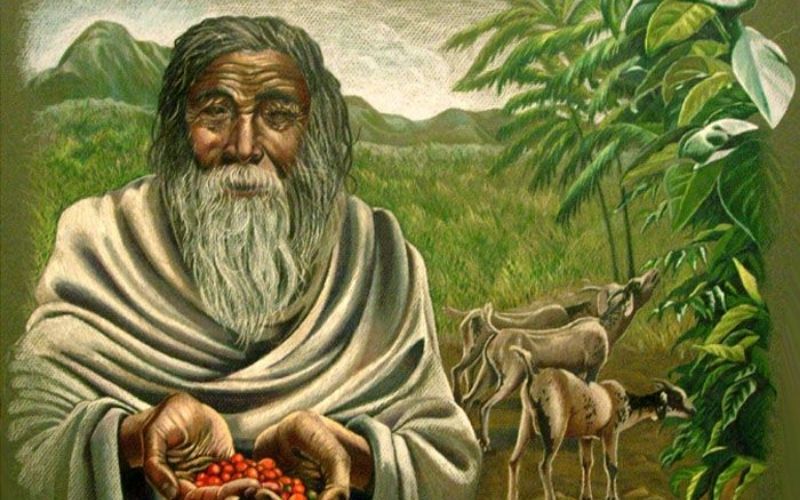
Global Distribution of Arabica vs Robusta Coffee
Arabica growing regions typically have elevations of 800–2,200 meters above sea level. Arabica beans are grown in areas with cool, humid climates, temperatures of 15–24°C, and annual rainfall of 1,200–2,200 mm. Major countries growing Arabica worldwide include:
Latin America region: Brazil, Colombia, Honduras, Guatemala East Africa region: Ethiopia, Kenya
Asia region: China, Yemen, India In Vietnam: Da Lat, Lam Dong, Son La, Quang Tri
Robusta growing regions have elevations of 0–800 meters, tolerating heat and humidity well. These areas have climates of 18–36°C with annual rainfall of 1,500–3,000 mm. Major countries growing Robusta include:
Vietnam: Dak Lak, Gia Lai, Dak Nong Indonesia: Sumatra, Java, Sulawesi India: Kerala, Karnataka Brazil: Espírito Santo, Bahia Some Central African countries like Uganda, Côte d’Ivoire, Republic of Congo
Specifically in Vietnam, Arabica coffee beans account for less than 10% of cultivation area, concentrated in Da Lat, Sapa, and Khe Sanh. These are cool areas with fog and loose soil. Meanwhile, Robusta beans occupy most of the Central Highlands area, suitable for large-scale cultivation with high yields and fewer diseases.
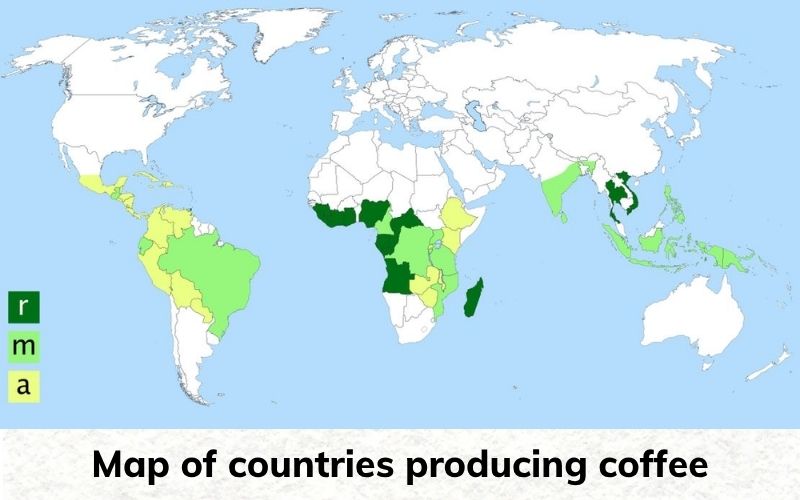
Distinguishing Arabica vs Robusta Beans
Each type of Arabica vs Robusta coffee bean has distinct characteristics in terms of bean shape, compound content, and flavor profile. Hello5coffee will help you distinguish between these two types of coffee beans through the following criteria.
Bean Shape and Size
Arabica beans are medium-sized, typically smaller than Robusta beans. Arabica bean shapes are slightly elongated with gently curved center grooves. The bean skin before roasting ranges from light green to dark green. The silver skin of Arabica beans is quite thin and easily separated when grinding.
Robusta beans are larger, rounder, and more robust than Arabica. The center groove is straight and well-defined. The skin color is dark green with thicker silver skin. Notably, Robusta beans resist pests and harsh weather conditions better.
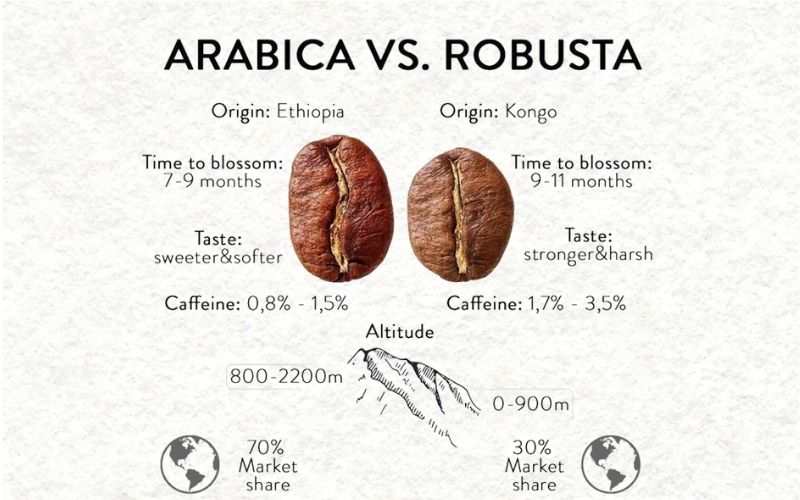
Chemical Composition
Arabica beans have relatively low caffeine content, around 0.8–1.4%. Fats (lipids) account for 15–17% of the bean, contributing to full body and fruity aroma. High sugar content (glucose, fructose) provides delicate sweetness. Chlorogenic acid in Arabica beans is lower than in Robusta, creating smoother acidity compared to Robusta beans.
Robusta beans have high caffeine content, around 1.7–4%, giving the coffee a strong bitter taste. Chlorogenic acid accounts for a large proportion, adding sharp acidity to Robusta beans. Fat content in Robusta is lower than Arabica, making the coffee body lighter. Low sugar content makes Robusta flavor less sweet.
Overall, the compositional differences make Arabica typically have complex aroma, smooth sweetness, and clean aftertaste. Robusta possesses smoky aroma, strong bitterness, and thick crema when brewing espresso. Roasters can adjust temperature to highlight these compounds: light roasting to emphasize Arabica’s gentle acidity, dark roasting to reduce Robusta’s harsh bitterness.
Arabica vs Robusta Flavor: Which Should You Choose?
Choosing between Arabica and Robusta depends on personal taste preferences, intended use, and your preferred brewing methods. You should choose Arabica if you’re sensitive to caffeine (since Arabica has lower caffeine content). Arabica coffee is also suitable for those who prefer light acidity, clean sweetness, and fruity, chocolate aromas. Arabica beans are perfect for gentle brewing methods like pour-over, cold brew, or French press.
You should choose Robusta if you prefer strong bitterness, intense aftertaste, sometimes slightly smoky. Need a coffee that provides quick alertness with high caffeine content. Robusta beans are suitable for brewing methods like espresso, moka pot, or traditional Vietnamese drip coffee. Robusta coffee tastes much better when prepared as beverages like iced milk coffee, egg coffee, or sweetened coffee.
Below is a comprehensive comparison table of the flavors of these two coffee types:
| Criteria | Arabica Coffee | Robusta Coffee |
|---|---|---|
| Flavor Characteristics | Gentle, refined, long-lasting aftertaste, less bitter | Rich, sharp, distinctly bitter, strong aftertaste |
| Sweetness | Natural, can taste fruit or caramel notes | Less sweet, often has earthy or woody taste |
| Acidity | Higher, clean tropical fruit acidity | Low, almost no acidic taste |
| Caffeine | Lower, about 1.2–1.5% | Higher, about 2.2–2.7% |
| Aroma | Complex, multi-layered fragrance | Simple, strong and rough |
| Suitable Roast Level | Usually light or medium roast to preserve delicate flavor | Usually dark roast to reduce sharpness and increase richness |
Pro tip: You can try blending Arabica + Robusta beans in ratios of 70:30 or 60:40 to achieve balance between sweetness and bitterness, perfect for espresso or milk coffee.
Global Commercial Market for Arabica vs Robusta Coffee
The global coffee trade operates with nearly 12 million export bags monthly, equivalent to over 8.5 million tons annually. This is also the total import volume of major markets combined. The increasing consumption trend forces importing countries to diversify supply sources and enhance sustainability standards.
Regarding demand by coffee type, Arabica beans account for higher consumption volume, with approximately 6.1 million tons of coffee sold. Meanwhile, Robusta has 4.5 million tons of coffee sold. By market region, Europe and North America account for the largest coffee import volume, with about 51.4% of total global coffee production. Asia follows with 25.8% and South America with 15.7% of global coffee production (source: ICO Coffee Report and Outlook).
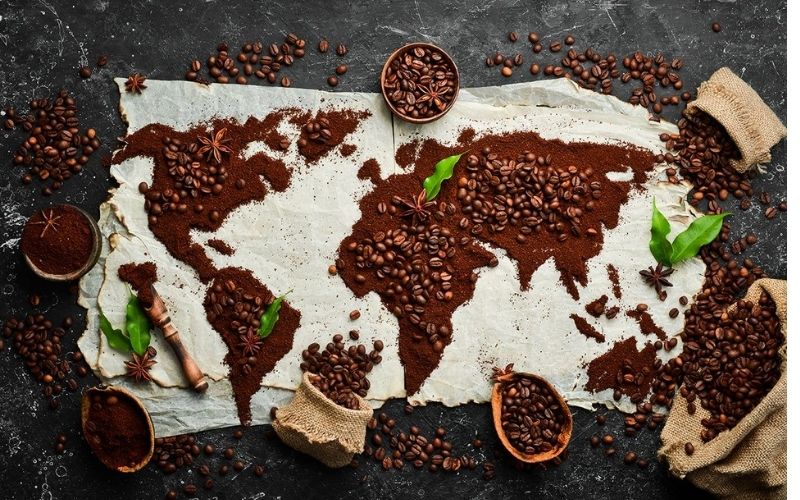
Regarding supply, Arabica accounts for about 60% of global coffee production. Brazil (accounting for 40% of global supply) and Colombia are the largest exporters. Robusta accounts for the remaining 40%, with Vietnam alone providing 15% of global Robusta production, and Indonesia being another country holding a large market share in the global coffee supply chain.
Top 5 Reputable Arabica and Robusta Coffee Suppliers in Vietnam
Among the dynamic landscape of Vietnam’s coffee industry, wholesale suppliers play a crucial role in the value chain from farm to cup. Below are the 5 most prominent enterprises in terms of scale, quality, and export markets.
Simexco Daklak
Simexco Daklak (2-9 Dak Lak Import-Export Company Ltd.) is renowned as a leading Robusta exporter worldwide. With over 30 years of establishment and development, Simexco specializes in purchasing, processing ripe beans, roasting and grinding, and exporting with a capacity of over 10,000 tons of coffee annually.
- Main products: Robusta beans, Arabica beans, green coffee beans, ground coffee
- Certifications: ISO 9001, HACCP; origin traceability commitment
- Export markets: Europe, North America, Japan, Middle East, and Eastern Europe
Modern warehouse capacity and processing lines help Simexco Daklak maintain stable quality, meeting strict requirements for moisture content, impurities, and bean size.
Vinh Hiep Joint Stock Company
Established in 1991 in Pleiku (Gia Lai), Vinh Hiep cooperates directly with over 10,000 farming households through sustainable cultivation programs.
- Main products: Robusta and Arabica green coffee, roasted ground coffee, instant coffee, pure and specialty coffee lines
- Export volume: About 81,000 tons of green coffee (2023/24 crop year)
- Export markets: European Union, United States, Japan, South Korea Certifications: HACCP, ISO 9001, Rainforest Alliance
Intimex Group Joint Stock Company
Originally an import branch in Saigon (1995), Intimex Group now manages 14 member units and 6 branches nationwide.
- Main products: Robusta & Arabica green coffee, roasted ground coffee, pepper, and other agricultural products
- Export volume: Over 570,000 tons annual throughput
- Export markets: Europe, North America, Middle East, ASEAN, China, Japan
Intimex’s strength lies in building a closed supply chain from cooperative partnerships to automated processing facilities. This helps them optimize operations and deliver high-quality products to customers.
Louis Dreyfus Company Vietnam
Louis Dreyfus Company Vietnam is a member of the LDC group. They leverage international trading platforms and risk management to trade all major Arabica and Robusta coffee products, serving diverse global customers from specialty roasters to multinational food companies.
- Main products: Robusta & Arabica green coffee, roasted ground coffee
- Production volume: Processes about 100,000 tons of green coffee through Vietnamese ports annually
- Export markets: Large roasters and instant coffee manufacturers in Europe, North America, and Asia
Louis Dreyfus Company Vietnam’s strength lies in financial stability, hedging capabilities, and integrated logistics from farm to export to ensure smooth order fulfillment processes.
Hello 5 Coffee
Established in 2012, Hello 5 Coffee quickly established itself as one of Vietnam’s leading coffee suppliers. Main products include Arabica-Robusta green coffee, roasted & ground coffee, drip coffee, and instant coffee, flexibly packaged according to OEM/ODM requirements. Hello 5’s strength lies in its closed supply chain from farm to roasting facility with 1,500 tons/month capacity, strict quality control processes meeting Halal, HACCP, ISO, and FDA standards, plus the ability to customize roasting and packaging to meet diverse partner needs domestically and internationally, with an export network spanning Europe, North America, Japan, and South Korea.
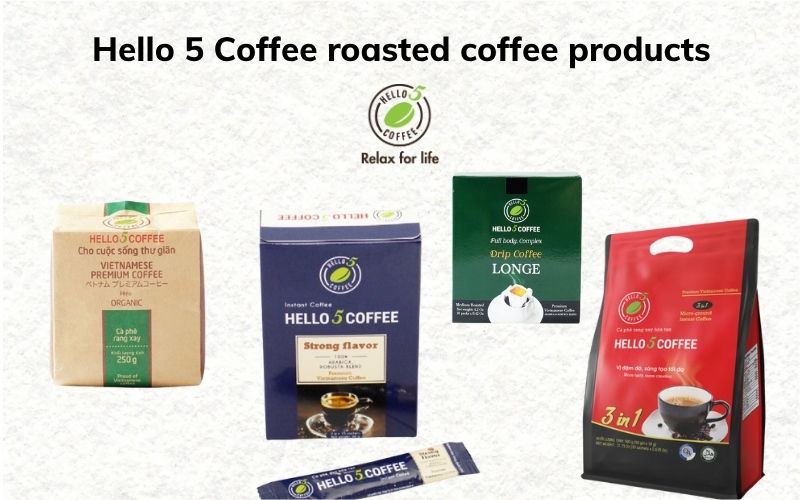
Conclusion
Both Arabica and Robusta have their own value, suitable for different preferences and brewing purposes. Now you know the differences between these two coffee varieties. Hello 5 Coffee hopes you will make the most suitable coffee purchasing choices for your market!
Contact us at:
- Hello 5 Coffee Global Joint Stock Company
- Email: info@hello5coffee.com
- Phone: (+84) 81 535 5505
- Head office: No. 73, To Hien Thanh Street, Phuc La Ward, Ha Dong District, Hanoi City.
